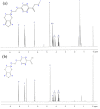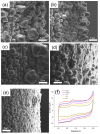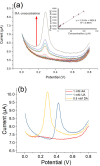Synthesis of MOF525/PEDOT Composites as Microelectrodes for Electrochemical Sensing of Dopamine
- PMID: 32878082
- PMCID: PMC7564993
- DOI: 10.3390/polym12091976
Synthesis of MOF525/PEDOT Composites as Microelectrodes for Electrochemical Sensing of Dopamine
Abstract
Dopamine (DA) is an important neurotransmitter responsible for the functions and activities of multiple systems in human. Electrochemical detection of DA has the advantages of fast analysis and cost-effectiveness, while a regular electrode probe is restricted to laboratory use because the probe size is too large to be suitable for an in vivo or in vitro analysis. In this study, we have developed porphyrin-based metal organic framework (MOF525) and poly(3,4-ethylenedioxythiophene) (PEDOT)-based composites to modify microelectrode for DA detection. Two types of PEDOT monomers with different functional groups were investigated in this study. By varying the monomer ratios, electrolyte concentrations, and electropolymerization temperature, it was found that the PEDOT monomer containing carboxylic group facilitated the formation of regular morphology during the electropolymerization process. The uniform morphology of the PEDOT promoted the electron transmission efficiency in the same direction, while the MOF525 provided a large reactive surface area for electrocatalysis of DA. Thus, the MOF525/PEDOT composite improved the sensitivity-to-noise ratio of DA signaling, where the sensitivity reached 11 nA/μM in a good linear range of 4-100 µM. In addition, porphyrin-based MOF could also increase the selectivity to DA against other common clinical interferences, such as ascorbic acid and uric acid. The as-synthesized microelectrode modified with MOF525/PEDOT in this study exhibited great potential in real time analysis.
Keywords: biosensor; dopamine detection; electrocatalysis; electropolymerization; microelectrode; poly(3,4-ethylenedioxythiophene) (PEDOT).
Conflict of interest statement
The authors declare no conflict of interest.
Figures










Similar articles
-
Direct in Vivo Electrochemical Detection of Resting Dopamine Using Poly(3,4-ethylenedioxythiophene)/Carbon Nanotube Functionalized Microelectrodes.Anal Chem. 2019 Oct 15;91(20):12917-12927. doi: 10.1021/acs.analchem.9b02904. Epub 2019 Sep 26. Anal Chem. 2019. PMID: 31512849 Free PMC article.
-
Discrimination of dopamine by an electrode modified with negatively charged manganese dioxide nanoparticles decorated on a poly(3,4 ethylenedioxythiophene)/reduced graphene oxide composite.J Colloid Interface Sci. 2021 Sep;597:314-324. doi: 10.1016/j.jcis.2021.03.162. Epub 2021 Mar 31. J Colloid Interface Sci. 2021. PMID: 33872888
-
Modulating Electrode Kinetics for Discrimination of Dopamine by a PEDOT:COOH Interface Doped with Negatively Charged Tricarboxylate.ACS Appl Mater Interfaces. 2019 Sep 18;11(37):34497-34506. doi: 10.1021/acsami.9b12946. Epub 2019 Sep 9. ACS Appl Mater Interfaces. 2019. PMID: 31449380
-
Microelectrode-Based Electrochemical Sensing Technology for in Vivo Detection of Dopamine: Recent Developments and Future Prospects.Crit Rev Anal Chem. 2022;52(3):544-554. doi: 10.1080/10408347.2020.1811946. Epub 2020 Aug 27. Crit Rev Anal Chem. 2022. PMID: 32852227 Review.
-
Synthesis and electrochemical sensing application of poly(3,4-ethylenedioxythiophene)-based materials: A review.Anal Chim Acta. 2018 Aug 31;1022:1-19. doi: 10.1016/j.aca.2018.02.080. Epub 2018 Mar 14. Anal Chim Acta. 2018. PMID: 29729729 Review.
Cited by
-
The Use of an Acylhydrazone-Based Metal-Organic Framework in Solid-Contact Potassium-Selective Electrode for Water Analysis.Materials (Basel). 2022 Jan 13;15(2):579. doi: 10.3390/ma15020579. Materials (Basel). 2022. PMID: 35057298 Free PMC article.
References
Grants and funding
LinkOut - more resources
Full Text Sources

